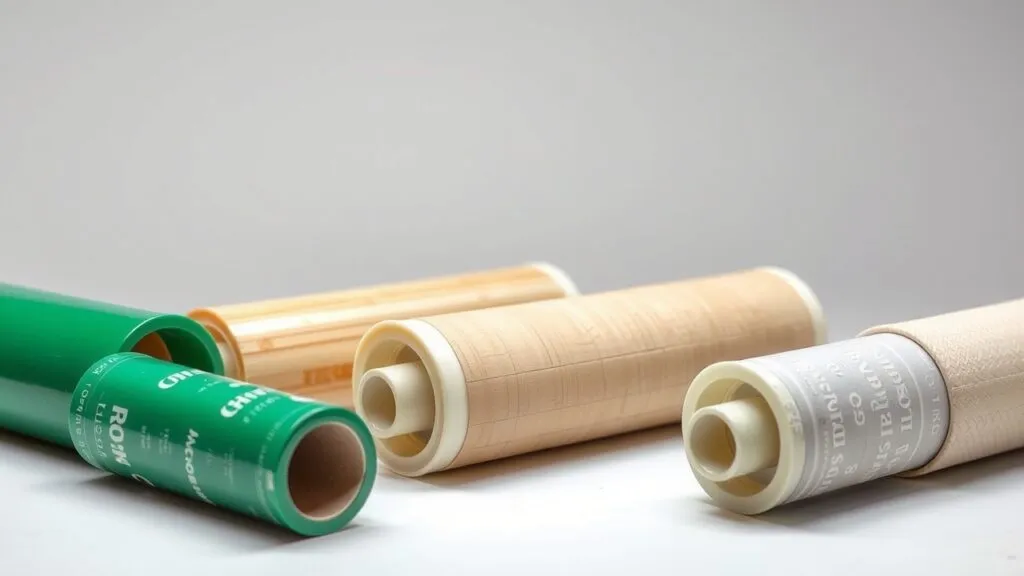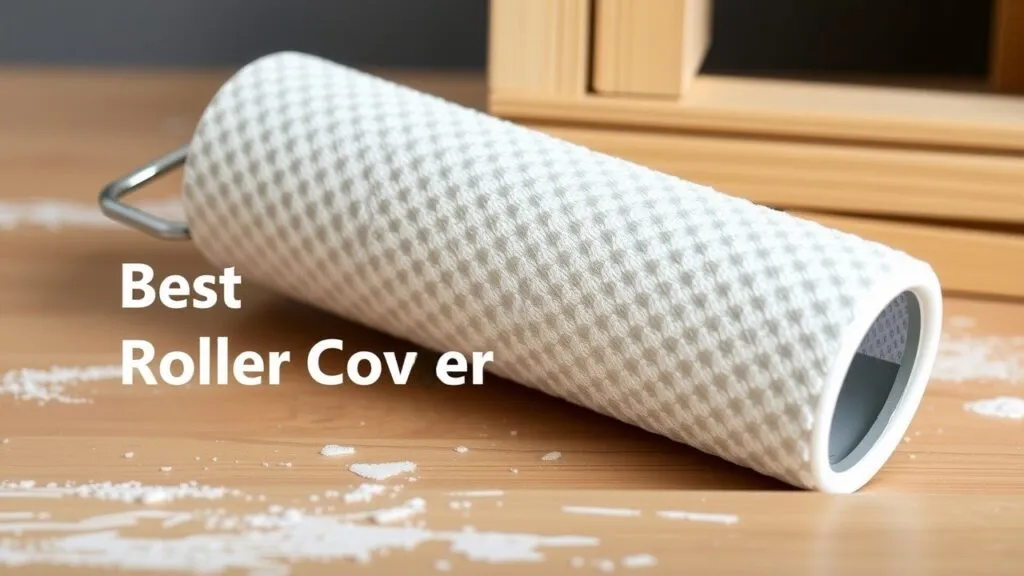Types of roller covers vary greatly, impacting paint application. This guide covers paint roller cover sizes and materials to help you choose the best one for your project, whether you need to paint smooth walls or textured surfaces.
What is a Paint Roller Cover?

A paint roller cover is a soft sleeve that goes over a paint roller frame. Its main job is to hold and spread paint on surfaces. Using a roller cover makes it easier to get an even coat of paint compared to using a brush. The right roller cover helps homeowners and painters finish their projects faster and with better results.
Components of Roller Covers
Paint roller covers come in different types, each for specific jobs. Here are some important parts to know:
- Nap Length: This is how thick the fibers are on the roller cover.
- Short nap (1/4 inch) works best for smooth surfaces like drywall.
- Long nap (3/4 inch or more) is better for textured walls or ceilings.
- Core Material: The core holds the fabric on the metal frame.
- Most cores are plastic or metal.
- Plastic cores are lighter but may not last as long under heavy use compared to metal ones.
- Fabric Type: Different materials change how much paint the roller holds and how it applies:
- Microfiber Roller Covers: These have fine fibers. They provide great coverage with less mess.
- Foam Roller Covers: Best for smooth finishes. They don’t absorb much paint but give a nice, smooth look.
- Lambswool Roller Covers: Made from natural wool. They are good for rough surfaces because they hold lots of paint.
- Nylon and Polyester Roller Covers: These are tough choices that work well with oil-based and latex paints. They give good coverage without shedding.
Knowing these parts helps you pick the best roller cover for your painting needs.
Why Choose the Right Roller Cover Matters?
Impact on Paint Application
Choosing the right roller cover affects how well paint goes on. Different types of covers apply paint differently, which can make a big difference in how your project turns out.
Quality of Finish
Using the right roller cover can change how nice the finish looks on different surfaces. A good choice will help you get smooth and even results.
Efficiency in Painting Projects
Having the right tools saves time during painting projects. It can make everything go quicker, so you don’t spend all day painting.
Avoiding Common Problems
Using the wrong or cheap rollers can lead to problems like streaks in your paint. Picking the correct roller cover helps avoid these issues, so your painting job looks great!
Roller Cover Materials: A Deep Dive
Microfiber Roller Covers
Microfiber roller covers are made from tiny synthetic fibers. They help with painting by giving a nice finish. There are two types: high-density and low-density. High-density covers work best on smooth surfaces. They make it easier to get a flawless look with less mess. These covers hold paint really well, so you can paint large areas quickly. They’re easy to clean, too! You can wash and reuse them many times. However, they might cost more upfront than other types like foam or polyester. Brands like Purdy and Wooster make good microfiber rollers.
Lambswool Roller Covers
Lambswool roller covers use natural wool fibers. These rollers are super strong and soak up paint really well. They shine when used on rough surfaces, such as stucco or brick. They can reach into small spaces, giving an even coat of paint without drips. The best part? They can hold a lot of paint at once, meaning fewer trips to the paint tray! But, they do need more care after using them. You should clean them well to keep them working great. Benjamin Moore has some good options for lambswool rollers.
Polyester Roller Covers
Polyester roller covers are flexible tools that work on many surfaces. You can find them in medium and high densities. They are affordable and perform decently, which is why many DIYers like them. These rollers apply both latex and oil-based paints nicely but watch out for shedding! Sometimes they can lose tiny fibers while painting, which could affect how your wall looks. Sherwin-Williams has some notable products in this category.
Nylon Roller Covers
Nylon roller covers have tough synthetic fibers that stand up to solvents in oil-based paints. They last a long time, making them great for repeated use on specific projects. While their durability is impressive, they come at a higher price than other types of rollers. Still, if you want something that lasts longer, nylon might be worth it.
Foam Roller Covers
Foam roller covers are special because they’re made for smooth surfaces like drywall or plaster finishes. They help apply paint evenly without leaving marks behind! For the best results, it’s smart to use foam rollers mainly with water-based paints since some solvent-based paints can break down the foam over time. Even though they’re quick and easy for small jobs, they do have limits when it comes to thicker paints that need heavier naps. Popular lines include those from 3M’s Paint Project series, which are designed for home improvement tasks needing fresh coats applied smoothly and quickly!
Roller Cover Nap Lengths: Choosing the Right Thickness
Short Nap Roller Covers (1/4″ – 3/8″)
Short nap roller covers are great for a smooth finish. They have nap lengths of 1/4 inch to 3/8 inch. These rollers are perfect for flat surfaces like walls and ceilings. They work well with latex paints. Plus, they cover well without leaving marks. If you’re looking for the best paint roller for a smooth finish, these are your top pick.
When you use short nap roller covers, they hold paint well and reduce splatter. If you’re painting trim or interior walls, these will help you get an even coat. They are useful when you need precision.
Benefits of Short Nap Rollers:
- Good for smooth surfaces.
- Excellent with latex paints.
- Minimal splatter and texture marks.
Medium Nap Roller Covers (3/8″ – 3/4″)
Medium nap roller covers range from 3/8 inch to 3/4 inch thick. These are super versatile! They work best on semi-smooth surfaces like lightly textured walls or drywall. You can use them with various types of paint.
In this range, the 3/8 inch and 1/2 inch nap roller covers are popular choices. They strike a balance between coverage and texture application. Using medium nap rollers helps prevent overloading the surface with too much paint.
Uses for Medium Nap Rollers:
- Good for semi-smooth finishes.
- Perfect on lightly textured walls.
- Works well with different paint types.
Long Nap Roller Covers (3/4″ – 1 1/2″)
Long nap roller covers come in thicker fibers, from 3/4 inch to 1-1/2 inches long. These high-nap rollers shine when covering rough surfaces like stucco or brickwork. If you’re working on outdoor projects or need extra durability in garages, these are your best tools.
The thicker fibers let these rollers get into crevices better than shorter naps can. So if you’re after the best paint rollers for rough surfaces, go for long nap options!
Highlights of Long Nap Rollers:
- Ideal for rough textures.
- Excellent coverage on stucco or brick.
- Reaches into crevices easily.
Nap Length Chart
Here’s a handy chart to compare the different nap lengths:
| Nap Length | Best For | Surface Type |
|---|---|---|
| Short (1/4″-3/8″) | Smooth finishes | Flat walls & ceilings |
| Medium (3/8″-3/4″) | Semi-smooth finishes | Lightly textured drywall |
| Long (3/4″-1-1½”) | Rough textures | Stucco & brick |
Knowing the differences in roller cover materials can really help your painting projects. It makes sure you choose the right tool based on what you need to do!
Roller Cover Sizes: Finding the Right Fit for Your Project
Mini Rollers
Mini roller covers are usually 4 inches wide. They’re great for small projects and tight spaces. You can use them on trim, cabinets, and furniture. The best thing about mini rollers is that they can reach places larger rollers can’t. But, they need more frequent paint refills since they’re smaller.
Best Uses:
- Touch-ups
- Small rooms or corners
- Detailed work on trim and moldings
Advantages:
- Easy to handle in tight spots
- Less overspray than larger rollers
- Good for intricate designs
Disadvantages:
- Takes longer to cover big areas
- Holds less paint than standard rollers
Standard Rollers:
Standard rollers are the most common type for DIY projects. These 9-inch roller covers strike a good balance between speed and control when painting walls or ceilings. They’re versatile enough for many paint applications.
Best Uses:
- Painting walls in medium to large rooms
- Ceilings
- Smooth surfaces
Advantages:
- Covers flat surfaces quickly
- Works with both latex and oil-based paints
- Easy to find in stores
Disadvantages:
- Harder to use in tight areas
- More overspray risk than mini rollers
Jumbo Mini Rollers:
Jumbo mini rollers are wider than regular mini rollers, usually around 6 inches. They cover more space but still work well for detailed tasks. This size is handy because it helps you finish quickly without losing precision.
Best Uses:
- Larger furniture pieces
- Medium-sized wall sections
- Textured surfaces
Advantages:
- Faster than standard mini rollers
- Good at evenly covering textured areas
Disadvantages:
- Not as effective on very rough textures
- Still limited compared to full-size standard roller covers
Choosing the Right Roller Size:
When picking a paint roller size, think about your project and the surface area you’ll be working on. Here are some factors:
- Project Size: For small jobs, use mini or jumbo mini rollers.
- Surface Texture: Rougher textures may need longer nap lengths found on standard or jumbo rolls.
- Paint Type: Different paints (like latex vs oil-based) may work better with certain sizes; thicker naps help apply heavier materials well.
Understanding these points will help you choose the right roller cover for your needs, making your painting project go smoother!
Roller Cover Cores: Durability and Longevity
Plastic Cores
Plastic roller cores are light and cheap. Many DIYers and pros like using them. They’re often found in disposable roller covers. These rollers have a smaller core diameter, making them easy to hold when you paint. They might not last as long as metal cores, but plastic cores still work well for quick jobs or small spaces.
When thinking about roller cover durability, remember that plastic cores are best for lighter paints, like latex. They soak up less paint than metal ones, so they’re good for fast projects. If you want something to toss after painting, disposable plastic roller covers are a great option.
Pros of Plastic Cores:
- Light and easy to handle
- Affordable for quick jobs
- Great for latex paints
Metal Cores
Metal roller cores are stronger and last longer than plastic ones. Pros love these reusable covers because they hold up well over time. The strong metal keeps the rollers in shape, even during tough projects or when using thick paints.
Most metal cores are made from steel or aluminum. This gives them strength without being too heavy. Metal-core rollers usually have a larger diameter than plastic ones, which helps them carry more paint. This means they can create smoother finishes on different surfaces.
Why Choose Metal Cores?
- Strong and durable for heavy use
- Ideal for oil-based paints
- Save money by reusing them many times
Investing in high-quality professional paint roller covers is smart since you can clean them easily and use them again without losing their effectiveness. Whether you choose plastic or metal cores depends on your painting needs, but knowing the differences will help you pick the right one!
Choosing the Best Roller Cover for Specific Surfaces & Paints

Smooth Surfaces
When you’re painting smooth surfaces like drywall or plaster, it’s super important to pick the right roller cover. The best roller covers for a smooth finish usually have a short nap. This means they have a pile height of 1/4 inch to 3/8 inch. These types of paint roller covers make it easy to get an even coat without leaving any texture marks. Microfiber and foam fabric roller covers are great choices. They hold paint well and give a nice, fine finish.
Key Features:
- Short Nap Length: Great for a sleek look.
- Material Options: Microfiber offers good coverage; foam is best for ultra-smooth finishes.
Semi-Smooth Surfaces
For semi-smooth surfaces, like lightly textured walls, you want a roller cover with a slightly thicker nap length—about 3/8 inch to 1/2 inch. This helps the roller reach into small imperfections while still giving a decent finish. The best roller cover for semi-smooth surfaces often includes polyester blends because they balance durability and good paint application.
Recommended Types:
- Nap Length: 3/8 inch to 1/2 inch.
- Materials: Polyester blends work great here because they hold and spread paint evenly.
Textured Surfaces
Textured surfaces need special care when choosing your roller cover. High-nap rollers (5/8 inch or more) are perfect because they can fill in grooves and bumps on walls really well. Low-nap rollers (1/4 inch) might not work since they won’t reach into the deeper textures as effectively.
Best Choices:
| Surface Type | Recommended Nap Length | Material Options |
|---|---|---|
| Textured Walls | 5/8 inch or higher | High-nap synthetic fibers |
Latex Paint
Latex paints are popular among DIY folks because they are easy to use and dry quickly. For latex paint application, microfiber and foam fabric roller covers are recommended. They soak up water-based paints nicely while making sure there’s less splatter. Using these materials makes it easier to get an even coat with fewer touch-ups needed later.
Top Picks:
- Microfiber Rollers: Absorb paint very well.
- Foam Fabric Rollers: Good for smooth finishes without lint.
Oil-Based Paint
When you’re working with oil-based paints, you need materials that can handle these thicker substances without falling apart too soon. Lambswool rollers are fantastic at this because they hold lots of thick oil-based paint easily. Polyester and nylon blend rollers also work well by giving you durability during application.
Ideal Materials:
- Lambswool Rollers: Perfect for heavy-duty jobs.
- Polyester/Nylon Blends: Strong and let go of paint well.
By knowing what each surface type needs and how different paints behave, you can choose the right roller cover for your painting projects. Making smart choices will help you get the best results every time!
Roller Cover Care, Cleaning, and Maintenance
Cleaning Roller Covers
Cleaning roller covers is super important. It helps them work better and last longer. For reusable roller covers, cleaning is a bit different depending on the paint type. If you used latex paint, rinse the cover with warm water right after you’re done. This way, most of the paint comes off before it dries. If you used oil-based paints, you’ll need something like mineral spirits.
Here’s how to clean your roller covers:
- Rinse: Rinse under running water to get rid of extra paint.
- Soak: Put some warm soapy water (for latex) or solvent (for oil-based) in a bucket and soak the roller for about 10-15 minutes.
- Scrub: Use a brush or your hands to scrub any leftover paint gently.
- Rinse Again: Make sure to rinse thoroughly until there’s no soap or solvent left.
- Dry: Let them air dry completely before you store them.
For disposable roller covers, just throw them away after use since they can’t be cleaned.
Maintaining Roller Covers
Taking care of your roller covers helps them last longer and keeps your painting projects looking good. Here are some easy tips:
- Clean reusable rollers right after painting. Dried paint can ruin them.
- Store cleaned rollers upright in a container or hang them up if you can. This keeps their shape.
- Don’t leave wet rollers wrapped in plastic; this can cause mold.
Following these tips will help you make your paint roller cover last longer.
Storage
Proper storage of roller covers helps keep them in great shape over time. Here are some smart storage tips:
- Keep Them Clean: Make sure all the old paint is gone before you store them.
- Use Containers: Store each cover separately in containers that let air in but keep dust out.
- Avoid Compression: Don’t stack heavy stuff on top of stored rollers; it can mess up their nap fibers.
These steps will keep your tools ready for your next project without losing quality.
When to Replace a Roller Cover?
It’s good to know when to get rid of a roller cover so your painting looks nice every time. Watch for these signs that mean it’s time to replace one:
- The nap feels flat instead of fluffy or worn down.
- You see damage like frayed edges or loose fibers that might fall onto surfaces when painting.
- You notice uneven application while using it even if you’re doing everything right—this often means it’s lost its ability to hold and spread paint evenly.
If you see any of these problems with your roller covers, think about getting new ones for your next project!
Frequently Asked Questions about Roller Covers
What is the Best Roller Cover for Textured Walls?
The best roller covers for textured walls have a long nap length, typically 3/4 inch or more. These types reach into the grooves and bumps well. High-nap synthetic fiber covers are ideal for this job.
How Do I Choose a Roller Cover for Different Paint Types?
Select microfiber or foam roller covers for latex paint. They hold water-based paints well and reduce splatter. For oil-based paints, lambswool or polyester blends work best, as they handle thicker substances effectively.
What Size Roller Cover Should I Use?
Use mini rollers (4 inches) for small areas and detail work. Standard rollers (9 inches) are great for walls and ceilings. Jumbo mini rollers (6 inches) cover more area but fit in tighter spots.
Are There Specific Roller Covers for Different Surfaces?
Yes, choose short nap roller covers for smooth surfaces like drywall. Use medium nap covers for semi-smooth surfaces and high-nap rollers for rough textures such as stucco or brick.
How Do I Maintain My Roller Covers?
Clean roller covers after each use to extend their life. Rinse latex paint out with warm water. For oil-based paints, use mineral spirits to clean thoroughly.
Additional Information on Roller Cover Types
- Nap Lengths: Understand short (1/4″-3/8″), medium (3/8″-3/4″), and long (3/4″-1 1/2″) naps.
- Materials: Choose between microfiber, foam, lambswool, polyester, and nylon.
- Sizes: Select from mini (4″), standard (9″), jumbo mini (6″), and larger sizes.
- Specialty Options: Explore anti-spatter roller covers or high-capacity designs.
- Core Types: Decide between plastic and metal cores based on durability needs.
- Application Techniques: Use methods like back rolling or wet edge to improve results.
By knowing these details, you can select the right roller cover for your next painting project.
Related Topics
- Types of paint roller covers
- Types of roller cover materials
- Types of roller cover nap lengths
- Types of roller cover cores
- Types of paint roller cover brands
- Types of surfaces for paint roller covers
- Types of paints for paint roller covers



Types of Roller Covers: A Complete Guide to Size, Material & More